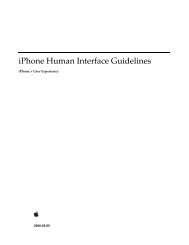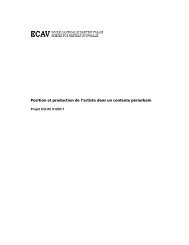iPod Notes Feature Guide (PDF) - Apple Developer
iPod Notes Feature Guide (PDF) - Apple Developer
iPod Notes Feature Guide (PDF) - Apple Developer
You also want an ePaper? Increase the reach of your titles
YUMPU automatically turns print PDFs into web optimized ePapers that Google loves.
C H A P T E R 2<br />
Creating Presentation Content<br />
■ Structure/hierarchy diagrams: Structure diagrams help sort and consolidate similar content and<br />
identify relationships between resources. They also can quickly expose ill-formed relationships,<br />
redundant content, and groupings of dissimilar materials.<br />
■ Directional diagrams: Known to programmers as flow charts, directional diagrams can suggest<br />
subtle logical interrelations that might otherwise not be obvious, and can quickly expose loops,<br />
missing connections, dead ends, and other navigational problems.<br />
■ Storyboarding: Storyboards illustrate concepts in sketch form, allowing proof-of-concept testing<br />
of style, taste, audience fit, and so forth early in the project, prior to investing time and development<br />
resources on potentially unimportant features.<br />
Note: The best presentations are often those that stem from the author’s interests, hobbies, or passions.<br />
In such cases, the author is likely to have a collection of relevant materials. If you are that author,<br />
your best bet might be to “work backwards”—to first gather those materials, organize them into<br />
logical categories, and let the content define the navigational structure.<br />
Once you’ve worked out the overall design for your presentation, you’re ready to build the content<br />
to populate it. This chapter shows you how that’s done.<br />
Note Files<br />
Fundamentally, a note is just a file with text to be displayed. In “Basic Uses of <strong>Notes</strong>” (page 9), you<br />
saw how easy it is to create a basic note file with any application that can handle text files. It’s a good<br />
idea to use the same application to write and edit all your notes, unless you are familiar with character<br />
encodings, line terminators, and file formats.<br />
As you write your note files, you should be mindful of the size of the <strong>iPod</strong> display. Occasionally,<br />
scrolling through a long passage is more convenient than moving through screen after screen. More<br />
often than not, however, keeping individual notes short improves the user experience by forcing your<br />
writing to be concise, reducing unnecessary scrolling, and maintaining a precise, uncluttered feel to<br />
the interface.<br />
As the number of notes increases, try to keep them sensibly organized in folders on your computer.<br />
Keep files with similar content grouped together, making them easier to find and easier to integrate<br />
into your presentation. Keep the number of files in a folder to five or six when possible. When the<br />
number of files grows, try to devise subcategories and add a folder for each subcategory, separating<br />
the files into the appropriate folders. This practice will help maintain sensible organization/structure<br />
while reducing the risk of content bloat and redundancy, and it will tend to keep your menus from<br />
overrunning the length of the <strong>iPod</strong> screen. Moreover, the default folder navigation facility allows you<br />
to load the entire hierarchy onto your <strong>iPod</strong> and quickly get a glimpse of how well it’s organized and<br />
where potential problems might lie.<br />
Develop simple, logical file naming conventions and use them consistently. To help you manage your<br />
notes efficiently, you should consider using some notation that identifies related notes as having a<br />
common theme or purpose. For example, notes about Europa in the astronomy example might be<br />
named something like JupMoonEuropa_atmosphere001.txt. Aside from clearly indicating the nature<br />
of the file’s content, this approach enables searching on a part of the name to locate entire grouped<br />
categories of content (JupMoon, for example, to find all content about moons of Jupiter). Another<br />
consideration is that you might want to avoid using spaces and special characters in file names if<br />
your software tools don’t handle such names well.<br />
20 Creating <strong>Notes</strong><br />
2006-11-02 | © 2006 <strong>Apple</strong> Computer, Inc. All Rights Reserved.





